Do you know what’s really in your cat’s food? It’s time to take a closer look at the ingredients listed on the label.
Fillers and additives are common in cat food, but not all of them are created equal. Some are harmless and even beneficial, while others can be harmful to your furry friend’s health.
As a cat owner, it’s important to understand what you’re feeding your pet. The quality of your cat’s food can have a significant impact on their health and well-being.
By learning about the different types of fillers and additives in cat food, you can make informed choices that will help keep your cat healthy and happy for years to come.
So, let’s dive into the truth about what’s really in your cat’s food.
Key Takeaways
– Understanding the ingredients in cat food is crucial for their health and well-being.
– Fillers and additives can be harmful to cats, and natural alternatives are recommended.
– Reading cat food labels and avoiding harmful ingredients like toxic preservatives, artificial colors, and low-quality protein is important.
– High-quality protein sources, natural preservatives and colors, and healthy carbohydrates are crucial for providing necessary nutrients and avoiding harmful additives in cat food.
Understanding Fillers and Additives in Cat Food
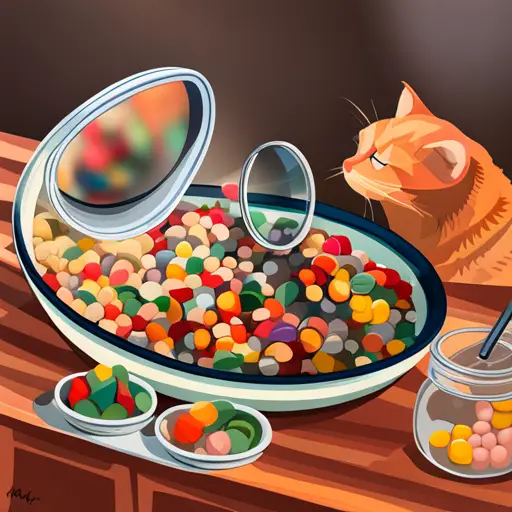
Don’t be fooled by fancy packaging or marketing claims, it’s important to educate yourself on the fillers and additives in your cat’s food.
Common fillers such as corn, wheat, and soy are often used to bulk up the food and reduce costs. These fillers have little to no nutritional value and can even be harmful to your cat’s health in large quantities.
Additive effects such as artificial colors, flavors, and preservatives are also commonly added to cat food. These additives can have negative effects on your cat’s health, such as allergic reactions or behavioral changes.
It’s crucial to pay attention to the ingredients sourcing of your cat’s food. Some cat foods use low-quality ingredients that can be harmful to your cat’s health.
It’s recommended to choose cat food that uses natural alternatives to fillers and additives, such as high-quality protein sources like chicken or fish. These natural alternatives provide your cat with the essential nutrients they need for optimal health and can reduce the risk of health issues associated with artificial additives.
Harmful Ingredients to Avoid in Cat Food
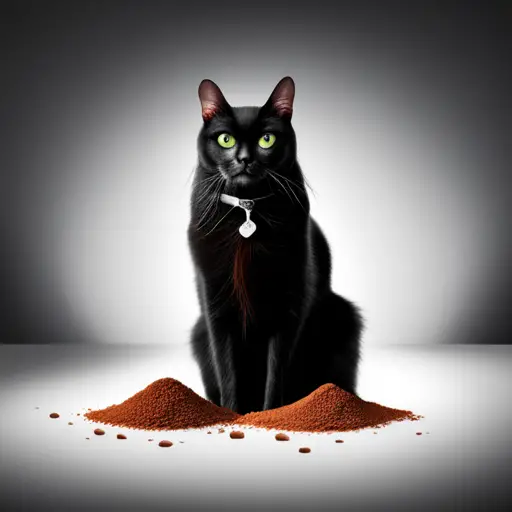
You want to steer clear of any ingredients that could potentially harm your feline friend, as the saying goes, you’re what you eat. Toxic preservatives, artificial colors, unhealthy carbohydrates, low-quality protein, and synthetic vitamins are all ingredients to avoid in your cat’s food.
Toxic preservatives, such as BHA, BHT, and ethoxyquin, have been linked to cancer and other health problems. Artificial colors, such as Yellow 5 and Red 40, have been linked to behavior problems and cancer. Unhealthy carbohydrates, such as corn and wheat, are difficult for cats to digest and can lead to weight gain and diabetes.
Low-quality protein, such as meat by-products, can lead to kidney and liver problems. Synthetic vitamins are not as easily absorbed by the body, and can lead to nutrient deficiencies. When choosing your cat’s food, make sure to read the label carefully and avoid any product that contains these harmful ingredients.
Look for foods that use natural preservatives, such as vitamin E and C, and natural colors, such as beet pulp. Choose foods that have high-quality sources of protein, such as chicken or fish, and avoid foods that use meat by-products or animal digest. Look for foods that have healthy carbohydrates, such as brown rice or sweet potatoes, and avoid foods that use corn or wheat.
By choosing the right food for your cat, you can help them live a healthier and happier life.
Nutritious Ingredients to Look for in Cat Food
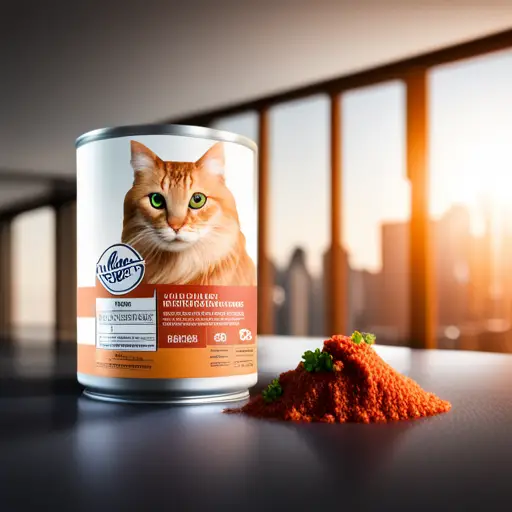
Discover the key ingredients that your furry friend needs to maintain good health and vitality. High protein sources are essential for cats, and should form the basis of their diet. Look for foods that contain real meat, such as chicken, turkey, lamb, or fish. These ingredients not only provide protein, but also essential amino acids that cats require for muscle growth, repair, and maintenance.
In addition to high-quality protein sources, your cat also needs essential vitamins and minerals to stay healthy. Look for cat foods that contain vitamins A, C, and E, as well as B vitamins, which are important for energy metabolism. Natural preservatives, such as tocopherols or vitamin C, are preferable to chemical preservatives, which can be harmful to your cat’s health.
If you’re looking for grain-free options, there are plenty of cat foods available that use alternative sources of carbohydrates, such as sweet potato or peas. Some cat owners also opt for raw food diets, which can provide a more natural and nutrient-dense diet, but be sure to consult with a veterinarian to ensure that this type of diet is appropriate for your cat’s individual needs.
Reading Cat Food Labels: What to Look for and What to Avoid
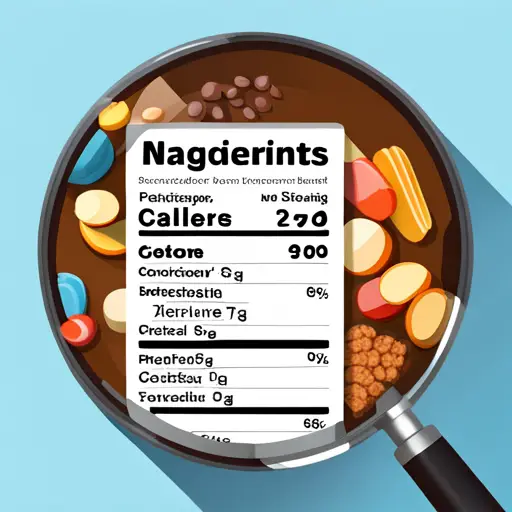
Understanding cat food labels can be confusing, but it’s important to know what to look for and what to avoid when selecting the best food for your furry friend. Choosing quality ingredients is crucial for providing your cat with the necessary nutrients and avoiding harmful additives.
When reading labels, make sure to look for whole meat sources as the first ingredient, as well as specific named sources of protein like chicken, beef, or fish. Avoid foods that list byproduct meals or vague ingredients like ‘meat meal’ or ‘animal digest’ as they may contain lower quality protein sources.
In addition, be wary of artificial colors, preservatives, and flavors, which can be harmful to your cat’s health. Opt for organic options whenever possible, as they’re free from pesticides and other harmful chemicals.
Be aware of controversial ingredients like corn, wheat, and soy, which may be used as fillers and can cause allergic reactions in some cats. By being mindful of hidden ingredients and avoiding harmful additives, you can ensure that your cat is getting the best possible nutrition from their food.
Making Informed Choices for Your Cat’s Health and Nutrition
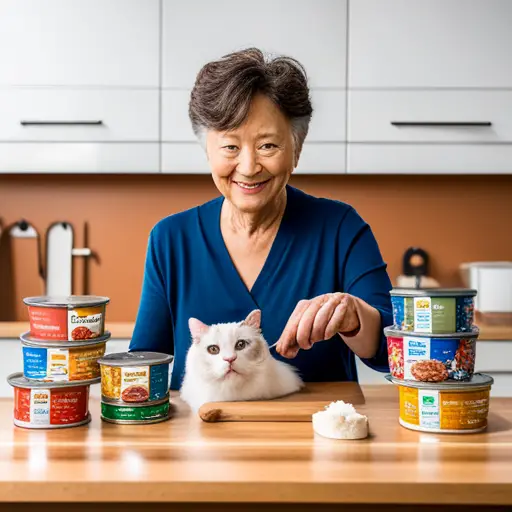
Choosing the right food for your furry companion is crucial to ensure their health and well-being, so it’s important to make informed decisions about their nutrition.
When deciding on your cat’s food, consider their feeding schedule, as well as any dietary restrictions or allergy management needs they may have. Some cats may require homemade options or cat-specific supplements to ensure they’re getting all the necessary nutrients.
It’s also important to do your research and read cat food labels carefully to avoid fillers and additives that can be harmful to your cat’s health. Look for high-quality protein sources and avoid ingredients like wheat, corn, and soy that can cause allergic reactions.
Ultimately, making informed choices for your cat’s nutrition can help them live a long and healthy life.
Conclusion
So, now that you know all about fillers and additives in your cat’s food, it’s time to take action.
Make sure you avoid harmful ingredients like artificial colors, flavors, and preservatives. Instead, look for nutritious ingredients like high-quality proteins, healthy fats, and essential vitamins and minerals.
When reading cat food labels, be sure to check the ingredient list and avoid anything that you know is harmful to your cat. Don’t be swayed by flashy marketing or misleading claims – always do your research and make informed choices for your cat’s health and nutrition.
After all, your furry friend deserves nothing but the best. So go ahead, give them the gift of a healthy and happy life by choosing the right food for them.
